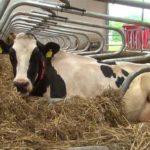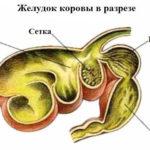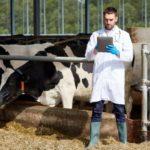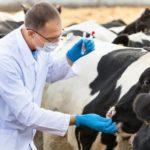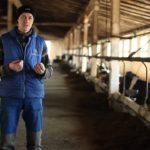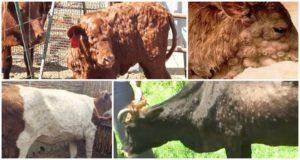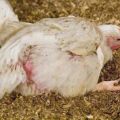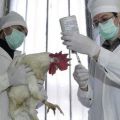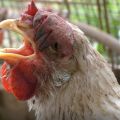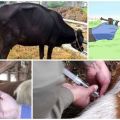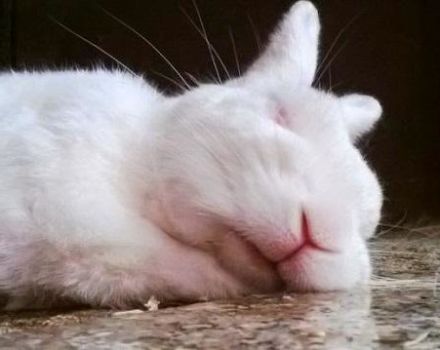Causes and symptoms of pancreatic atony in cattle, methods of treatment and prevention
Cattle are characterized by a complex digestive system, the functioning of which depends on many factors. The cause of the appearance of atony of the proventriculus may be an improper diet or poor quality food. If you do not take action right away, there is a risk of negative consequences. These include stomach obstruction and even death. Therefore, the very first signs of pathology should be the basis for contacting a veterinarian.
Description of the disease
The state of atony of the proventriculus in cattle is accompanied by a decrease in the contractile activity of some parts of the stomach - in particular, the mesh, omasum and scar. In this case, weakness or complete absence of contractions is observed. Of course, such a low digestive activity affects the state of the animal and its mood.
Improper diet is considered a common cause of the development of the disease. The main factors in the appearance of atony include:
- an excess of heavy and roughage in the diet - for example, a lot of hay or straw against the background of an insufficient amount of succulent feed;
- the use of cold or dirty water, which contains many pathogenic microorganisms and impurities;
- a sudden transition from one type of food to another - for example, replacing juicy grass with dry compound feed;
- poor-quality food - rotten roots, moldy feed, low-grade concentrates can become the cause of problems;
- infectious diseases or infection of an animal with parasites.
Often atony appears in the fall, when, after systematic grazing and green grass, the animal is transferred to compound feed.
Other factors that cause problems include:
- loud noise;
- transportation of animals in transport;
- long distance haul;
- severe stress;
- lack of systematic walking.
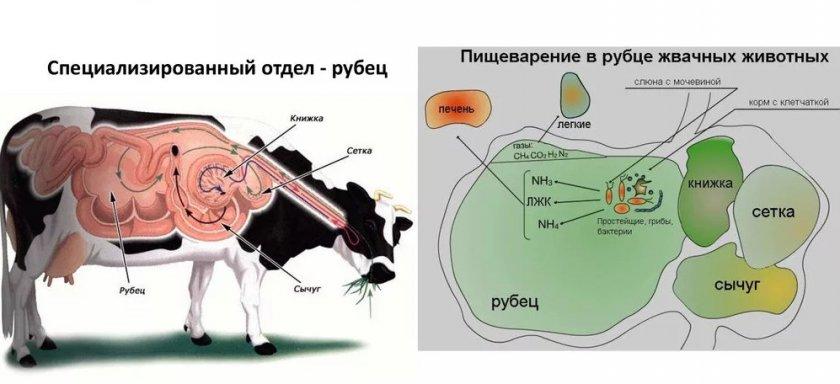
Forms and symptoms of the disease
The following symptoms are characteristic of stomach atony:
- loss of appetite;
- decrease in milk yield;
- general lethargy;
- an increase in temperature up to 40 degrees;
- sudden weight loss;
- dense brown feces or its complete absence.
When palpating the abdomen, one feels that the scar has become dense and does not shrink. In a normal state, the number of contractions before meals is 2-3 in 2 minutes. After eating, this parameter increases up to 5 times. The appearance of atony provokes a strong decrease in the number of contractions. With complex forms of atony, they completely stop. Against the background of infections, complex forms of endometritis or mastitis, with helminthic invasion, the likelihood of secondary atony is high.
At the initial stage of the appearance of pathology, a decrease in scar contractions is observed. This stage of the disease is called hypotension. The first signs of the onset of the disease include belching with gases and the absence of chewing gum. Acute hypotension is characterized by a sharp development. For several hours in an animal, the scar stops shrinking, and its condition is disturbed. The first signs of atony and hypotension include a deterioration in appetite and a tendency to stagnate. At the same time, the farmer should immediately notice such changes in the pet's behavior and take appropriate measures. The most characteristic symptom of atony is the cessation of belching.
When such signs appear, you need to feel the stomach. If the number of contractions is less than 1-2 in 5 minutes, this indicates the development of hypotension. In such a situation, urgent action is required.
How is atony diagnosed in cattle
To diagnose atony in a cow, the veterinarian takes the history and clinical symptoms of the disease. If hypotension is of secondary origin, signs of the underlying ailment are added to the symptoms of hypotension.

It can be ketosis, gastroenteritis, osteomalacia. There may also be signs of acobaltosis and acetonemia. During pregnancy, hypotension is characterized by a slow development and increases towards the end of this period. Differential diagnostics is of no small importance. The veterinarian needs to exclude traumatic reticulitis, osteomalacia, ketosis. You should also distinguish atony from gastroenteritis, blockage of the book, mastitis, endometritis and other pathologies.
Methods for treating pathology in cattle
Treatment of pathology should be aimed at restoring motility and secretion of the proventriculus. The restoration of their microflora, the fight against putrefactive processes and intoxication are of great importance. If you start adequate therapy on time, it will be possible to normalize the animal's condition in the first 3 days.
Veterinary drugs
Disease therapy should be handled by an experienced veterinarian. First, it is recommended to remove food that is stagnant. For this, a 1% solution of sodium sulfate or sodium bicarbonate is used. It needs to be mixed with 30-40 liters of water.
With a decrease in pressure, sodium chloride is injected into the vein. This also reduces symptoms of intoxication and increases muscle contractions. After removing food, you should worry about the normalization of motor and secretory functions. To obtain such results, it is recommended to introduce a pharmacy infusion of hellebore root. Intravenously, it is worth using 2-3 milliliters of the drug, orally - 5 milliliters. The components of this substance help to stimulate muscle contractions. For oral administration, the infusion is recommended to be mixed with water.
In addition, for therapeutic purposes it is worth using "Pilocarpine", "Physostigmine", "Proserin". To stop fermentation and putrefaction in the digestive organs, it is recommended to use Ichthyol. For 1 liter of water, it is worth taking 15 milliliters of the product. The composition should be administered twice a day. Creolin is also suitable.
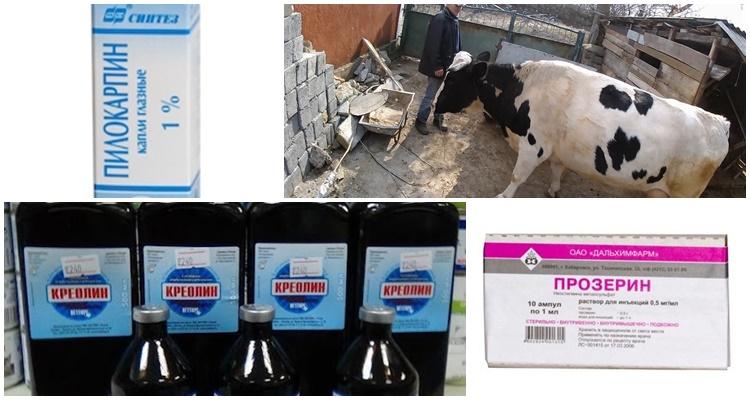
Folk remedies
Homemade recipes improve the functioning of the digestive organs, but are not able to cleanse the body of toxins. Therefore, before using such funds, it is important to wash the stomach. To prepare a stimulating composition, you will need 50 milliliters of alcohol, 100 grams of yeast and 200 grams of sugar.Mix the finished composition with 1 liter of water and give to the animal. The mixture is applied again after 1-2 days.
Walking and massage
To restore motility, the animal needs to move more. If it lies all the time, the treatment will have no effect. The cow needs to walk at least 20-30 minutes 2-3 times a day. A sick animal should be massaged for 10-20 minutes. The procedure should be done 2-4 times a day. In this case, it is recommended to perform smooth circular movements.
Proper nutrition
Until the condition stabilizes, the cow should not be fed. To prevent dehydration, you should use only pure water. After cleansing the stomach and eliminating inflammation, it is permissible to feed the pet. In this case, it is worth giving him greens, chopped root vegetables and hay. Rough feed will have to be abandoned.
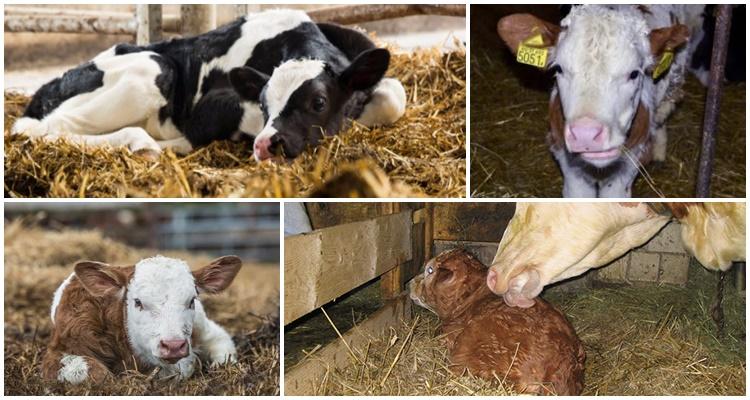
Prevention and prognosis
To avoid problems, you should follow these rules:
- walk the animal regularly;
- choose the optimal amount of food;
- control the quality of feed;
- pre-steam the straw;
- make a balanced diet;
- give clean water.
With proper care and timely assistance, pathology is easily treatable. Atony of the proventriculus is a complex pathology that is associated with violation of the rules for keeping animals. The disease is treatable, so it is so important to immediately contact your veterinarian.
